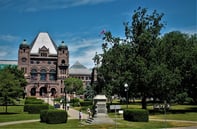Published on
The Power of Partnerships and Pairings: Why STEM and Liberal Arts are Better Together

“The last decade has seen considerable energy and enthusiasm for mash-ups between the STEM disciplines and the liberal arts disciplines, with motivations ranging from practical to political, obvious to opportunistic, and sensible to silly.” –D. Rosowsky, 2016
I feel as though I have “come of age” as an academic leader in this time of growing tension between STEM and the liberal arts. While it is important to fully understand why these tensions have increased and caused communities on our campuses to entrench, put up defences, and even do battle, it is perhaps more important to continue to seek to remove barriers, engage productively, and create deeper and more purposeful partnerships.
I am not so naïve as to think this is simple, and I have tried (and both succeeded and failed) in these efforts, but I will continue to seek ways to bridge this somewhat artificial and certainly counterproductive divide. Such partnership is in my academic history and DNA, something in which I believe deeply and for which I have great passion and energy.
We know the reasons, we have heard the narrative, and we can appreciate the positions of those in the liberal arts. Steep and seemingly enduring declines in enrollments in many of these disciplines have been seen nationally. This has created all sorts of false narratives about university intentions, administrative priorities and even the value of the liberal arts. The realities are far simpler but seem more difficult to recognize or accept.
The recession and slow recovery, and concerns over post-graduation employment, have changed what students and families expect of a college degree. Related to this value proposition argument, the continued disinvestment by states in public higher education has passed on costs to universities and families. These factors may be viewed as beyond our control. Within our control, however, is how institutions and faculty respond. While universities have come to understand the hard realities of changing demographics—in applications, enrollments, or students’ choice of majors—faculty in many traditional liberal arts disciplines have reacted defensively rather than opportunistically. It is hard not to view this decline in interest as an indictment of the discipline. But it’s a call to action, not a terminal diagnosis. Some disciplines are more comfortable with partnering across disciplines. Others are more solitary and discipline-specific. Faculty have been trained in the scholarship—and the culture—of their academic discipline. This makes the call for interdisciplinarity, academic partnerships and even broadening of academic offerings difficult for some. For others, it is far easier, part of the culture and even part of the disciplinary training.
I have spent years working to understand and smooth this divide, which to me seems both unnecessary and counterproductive. But the divide is real and it drives campus narratives as well as national discourse. It also impacts public perception of the value of higher education and the role of the liberal arts, understanding of shared governance, and attitudes toward faculty. It thwarts potentially exciting and impactful opportunities for our students (traditional, new traditional, and non-traditional), creates faculty camps that often use the disciplinary debate as a surrogate for other matters, and erects powerful barriers to progress and evolution on our campuses.
University senior leaders must continue to listen, seek to understand, and put forward possible solutions. We must be willing to insert ourselves into college and department faculty conversations where our input, and certainly our direction, is not always welcomed. This requires building bilateral trust, founded on respect and understanding, and taking the time to clearly explain motivations as well as goals. We must also be willing to try and fail, and try again. Building that trust can also result in new strategies for success.
The Rhetoric: An Array of Acronyms
Full disclosure, as a former engineering dean at a private technological research university and provost at a comprehensive public research university, I have not always been an early adopter (or believer) of many “big fads” that have been bred by or levied upon higher education. My patience, critical thought, and even skepticism have (often, not always) paid off. I was vocal among my colleague deans and provosts that MOOC’s, for example, would not replace or even substantially alter how we educate most university students.
Rather, I posited, we would settle into a sensible and compelling role for online and other non-traditional modes of pedagogy to augment and enhance campus-based education. As another example, I have never been compelled by the “STEAM” acronym, forcing the arts to somehow exist between engineering and mathematics—an awkward bridge (however clever an acronym) that raises more questions than it answers and diminishes (however unintentionally) the importance and relevance of the arts.
To me, it appeared an attempt to say, “Hey, STEM is getting all the attention. We are the arts and we matter too, so let’s plug ourselves in here.”
In fact, there are tremendous opportunities to partner STEM with the arts around design, human/environment interaction, functional aesthetics, visualization, etc. But we need to be more intentional in how we speak about this intersection. STEAM has always felt a bit clumsy to me. We can do better, many universities are.
The Sensible: Persuasive Partnerships
I am on record, even when I was a dean at a technological research university, saying that the future of engineering education does not lie in the polytechnic institutions, but rather in the comprehensive universities. Today’s engineers, are being called upon to lead teams of diverse discipline professionals to solve great and complex challenges. It only makes sense, therefore, that we must prepareengineers to do so. This includes broad and relevant topics throughout the university, in liberal arts, business, education, policy and more. And those we prepare to take on global challenges, and indeed to live and work around the globe, must be culturally sensitive and competent.
The necessary communications skills required now reach far beyond writing and speaking to include the digital, the cultural, the sustainable and the socially responsible. So the case, at least for me, is clear: We must not only make room for engineering students to take liberal arts courses, we must make it anexpectation, while also helping them make smart choiceswhen selecting courses given the limited room in the engineering curricula.
But we can arrive at the same conclusion coming from the other direction. Those who graduate with a degree in liberal arts will be called upon to forge solutions to the grand challenges of our time, whether through the lens of their discipline or as members of interdisciplinary teams. They will live and work in a world that requires a degree of literacy and competency in mathematics, life sciences, physical sciences, finance, computer science and coding. These skills are every bit as important as social skills, communication skills, cultural competency and critical thinking skills.
We do our college graduates (and those they will influence throughout the course of their lives) a disservice by failing to ensure they are equipped to thrive and to succeed in our world.Those seeking degrees in humanities, social sciences and the arts—as well as those in non-STEM professional disciplines such as education and business—should be encouraged, expected and enabled to take an appropriate suite of classes in the STEM disciplines. Many colleges and universities have distribution requirements, but do their students understand why they are taking those courses? Are they forging and exploring the connections between their STEM courses and humanities or social sciencescourses?
Smart selections of courses could result in program pairingsbetween a disciplinary major and a complementary certificate, minor, second major or post-graduate degree. We should encourage students to pursue these program pairs, while discouraging them from simpler paths (e.g., a random selection of introductory courses to satisfy elective requirements, or a minor or second major that is very close to the original major). Universities and their faculty should be thoughtful about designing program pairs, clearly articulating (and demonstrating) their value, and promoting them as part of the institution’s commitment to their students’ success.
This does not require that we create a mash-up or a clever acronym. It does, however, compel us to think carefully about how best to serve our students and prepare them for success. We should be purposeful and strategic in empowering our students to make good choices in rounding out their curricula, realizing the fullest value of their higher education and leveraging all that the university offers during their years here.
Partnerships between faculty in STEM and liberal arts disciplines will expand faculty perspectives and thinking about new programs and new pedagogies that broaden the university’s reach to pre-college and adult learners. Imagine a pre-college program aimed not just at giving high school students a head start on college, but at providing pre-college students with credit-bearing opportunities to explore emerging disciplines that are supporting some of the most exciting new careers, to learn about how STEM and liberal arts fields support and empower one another, and become excited about pursuing their own program pairs in college.
Most returning college students (adult learners returning with the goal of completing their degree) are not seeking a traditional disciplinary path. Rather, they are seeking the most efficient, cost-effective and productive path that will maximize the value of their commitment through new knowledge and transferable skills. In the cases of both of these non-traditional audiences, programs created and delivered jointly by faculty in STEM and liberal arts disciplines may be most attractive and most successful.
The case for partnership between STEM and liberal arts is clear. It meets the needs of our traditional campus-based undergraduate and graduate students, reaches new audiences of pre- and post-baccalaureate students, creates new programs that attract new students and faculty, and changes campus culture to reflect our changing world. There is power in the partnership. Each enhances the other, and the combination is potent indeed. Just look around at the global innovators, thought leaders and change agents. They are not monochromatic or unidimensional. They are broad and integrative thinkers who are as skilled within their discipline as they are moving across disciplines. It is not enough to build teams of disciplinary experts to solve interdisciplinary challenges, our graduates must be skilled disciplinary integrators with common language and common understanding. And this goes in both directions.
So perhaps we should stop the “either-or” rhetoric and co-existfor the betterment of our students, our universities and society. These are highly complementary collections of disciplines. We should be working together to create sensible, relevant and important curricula and program pairings. Hofstadter called it “an eternal golden braid.” STEM and liberal arts. Full STEAM ahead.
This article was revised from an earlier version and reissued in June 2019.



